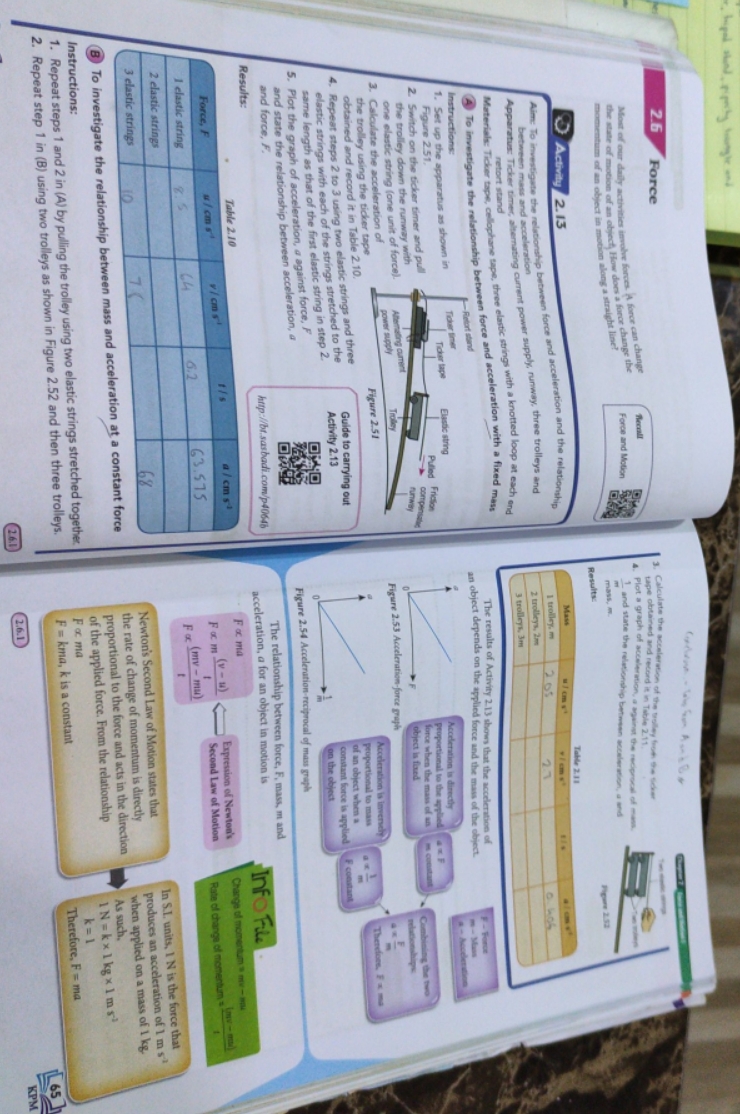pls help me
2.6 Force 1.C s involve forces. A foror can change Recall Calculate the kesleration of the trolley foot the Sicker tape obtained and record it in Table 2.11. on of an object How does a foror change the Force and Motion 4. Plot a graph of acceler 1. and state the relationship bet tion, a against the rec sotion along a straight line? tocal of man am of an obje mass, A ation, a and Results Piper 2.52 Activity 2.13 onship between force and acceleration and the relationship Mass Table 2.11 the re I trolley, m ating current power supply, runway. three trolleys and 205 2 trolleys, 2m 21 : Ticker timer, retort stand 3 trolleys, 3m Mat call: Ticker tape, cellophane tape, three elastic strings with a knotted loop at each and to investigate the relationship between force and acceleration with a fixed mass -Fiedart stand The results of Activity 2.13 shows that the acceleration of an object depends on the applied force and the mass of the object. 1. Set up the apparatus as shown in Figure 2.51, Ticker tape Elastic string Pulled Friction Acceleration is directly N Switch on the ticker timer and pull proportional to the app the trolley down the runway with company funway force when the mais of an one elastic string (one unit of force) ing cumin object is found Calculate the acceleration of power supply Trolley Figure 2.53 Acceleration-force graph the trolley using the ticker tape Figure 2.51 obtained and record it in Table 2.10. proportional to mass endors, F . ma Repeat steps 2 to 3 using two elastic strings and three elastic strings with each of the strings stretched to the Guide to carrying out of an object when a Activity 2.13 same length as that of the first elastic string in step 2. constant force is applied on the object 5. Plot the graph of acceleration, a against force, F and state the relationship between acceleration, a Figure 2.54 Acceleration reciprocal of mass graph and force, F. Results: hrip://br.saxbadi.com/p40646 The relationship between force, F, mass, m and acceleration, a for an object in motion is Table 2.10 Info File Force, F w / cms' 1/s a / cms For ma Form (v - 1) Expression of Newton's Change of momentum a my - mu I clastic string 8.5 6.2 63.575 Second Law of Motion Rate of change of momentum : Snow - med) For (mv - mu) 2 elastic strings 3 elastic strings In S.1. units, 1 N is the force that Newton's Second Law of Motion states that produces an acceleration of 1 m s B To investigate the relationship between mass and acceleration at a constant force the rate of change of momentum is directly when applied on a mass of 1 kg. proportional to the force and acts in the direction As such. Instructions: of the applied force. From the relationship IN = kx lkg x Ims' 1. Repeat steps 1 and 2 in (A) by pulling the trolley using two elastic strings stretched together. F o ma k = 1 2. Repeat step 1 in (B) using two trolleys as shown in Figure 2.52 and then three trolleys. F = kra, k is a constant Therefore, F = ma 65 2.6.1 KPM







